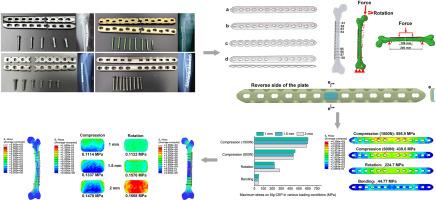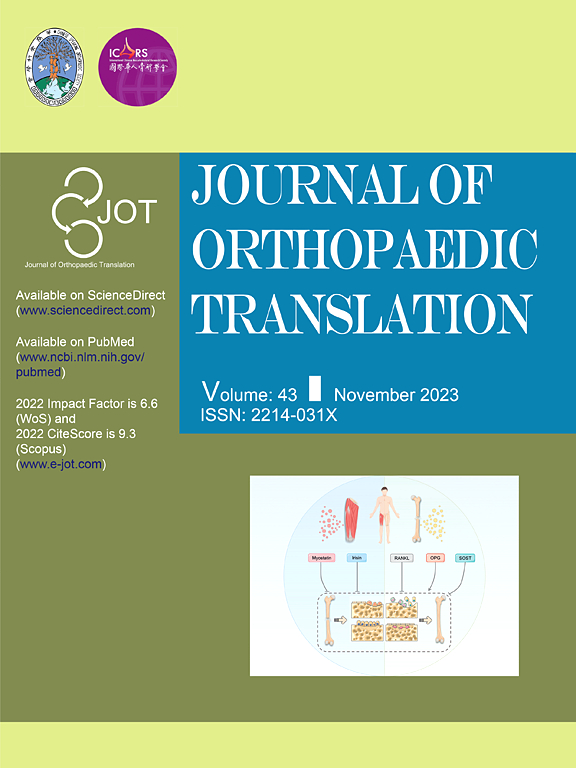翻修手术中取出的钢板的故障分析和设计改进
IF 5.9
1区 医学
Q1 ORTHOPEDICS
引用次数: 0
摘要
背景骨板骨折会给患者带来巨大痛苦,并增加公共财政负担。本研究旨在探讨翻修手术中取出的 49 块骨板的断裂机制,并引入纯镁块,通过降低刚度改善骨板的生物力学性能,并通过镁块的降解潜在地刺激骨板的生物反应。方法对骨板进行形态分析和成分分析,结合临床数据确定骨板的断裂原因。根据结构特征,将检索到的 49 块钢板分为:传统钢板(TP)、非对称钢板(AP)、重建钢板(RP)和中央增强钢板(CEP),并分别将其结构特征归一化为商用钢板。使用经过验证的股骨有限元模型对这些钢板的生物力学性能进行了评估。结果表明,回收的钢板主要因延迟结合或不结合引起的疲劳断裂而失效(44/49),与钛合金钢板相比,在发生延迟结合或不结合时,在负重区使用纯钛钢板会增加骨折风险。TP 具有最高的抗压性和抗弯性,而 CEP 具有最高的抗旋转性。随着镁块厚度的增加,钢板的压缩应力降低,但旋转应力增加。带有 1.5 毫米镁块的钢板具有出色的抗压、抗弯和抗旋转性能。在钢板中加入镁块可改善生物力学性能,并具有促进骨愈合的潜力。这项研究评估了取骨钢板的失效机制,并利用这些数据开发了一种新型钢板,在骨折线相应位置加入了1.5毫米的纯镁块。由于减轻了应力集中,新型骨板表现出优异的抗压、抗弯和抗旋转性能。镁块具有随时间降解的潜力,可促进断裂愈合,防止钢板疲劳断裂。本文章由计算机程序翻译,如有差异,请以英文原文为准。

Failure analysis and design improvement of retrieved plates from revision surgery
Background
The fracture of bone plate can cause considerable pain for the patient and increase the burden on the public finances. This study aims to explore the failure mechanism of 49 plates retrieved from revision surgery and introduce pure magnesium (Mg) block to improve the biomechanical performance of the plate via decreasing the stiffness and to stimulate the biological response of the plate potentially by the degradation of Mg block.
Methods
The morphological analysis and component analysis of the plates were conducted to determine the fracture reason of the plates combining the clinical data. According to the structural feature, the 49 retrieved plates were divided into: traditional plate (TP), asymmetrical plate (AP), reconstructive plate (RP) and central enhancement plate (CEP), and their structure features are normalized in a commercial plate, respectively. The biomechanical performance of the plates was evaluated using a validated femoral finite element model. A block of pure Mg with a thickness of 1 mm, 1.5 mm and 2 mm was also incorporated into the CEP to be assessed.
Results
The results indicated that the retrieved plates mainly failed due to fatigue fracture induced by delayed union or nonunion (44/49), and using pure titanium plates in weight-bearing areas increased the risk of fracture compared with Ti alloy plates when the delayed union or nonunion occurred. The TP demonstrated the highest compression resistance and bending resistance, while CEP had the highest rotational resistance. As the thickness of the Mg block was increased, the stress on the plate in compression decreased, but the stress in rotation increased. The plate with a 1.5 mm Mg block demonstrated excellent compression resistance, bending resistance and rotational resistance.
Conclusion
Fatigue fracture resulting from the delayed union or nonunion is the primary failure reason of plates in clinic. The incorporation of Mg block into plate improves the biomechanical performance and has the potential to promote bone healing. The plate with a 1.5 mm Mg block may be suitable for use in orthopaedics.
The translational potential of this article
This study assessed the failure mechanism of retrieved bone plates and used this data to develop a novel plate incorporating a 1.5 mm block of pure Mg block at the position corresponding to the fracture line. The novel plate exhibited excellent compression resistance, bending resistance and rotational resistance due to the alleviation of stress concentrations. The Mg block has the potential to degrade over time to promote fracture healing and prevents fatigue fracture of plates.
求助全文
通过发布文献求助,成功后即可免费获取论文全文。
去求助
来源期刊

Journal of Orthopaedic Translation
Medicine-Orthopedics and Sports Medicine
CiteScore
11.80
自引率
13.60%
发文量
91
审稿时长
29 days
期刊介绍:
The Journal of Orthopaedic Translation (JOT) is the official peer-reviewed, open access journal of the Chinese Speaking Orthopaedic Society (CSOS) and the International Chinese Musculoskeletal Research Society (ICMRS). It is published quarterly, in January, April, July and October, by Elsevier.
 求助内容:
求助内容: 应助结果提醒方式:
应助结果提醒方式:


